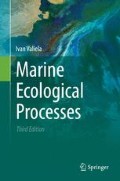Abstract
No assemblage of organisms remains unchanged for long; the often-quoted “balance of nature” is largely a fiction; natural assemblages are seldom in stasis nor is any one current state a lasting condition. Daily, seasonal, and decadal shifts in weather and climate impart changing patterns to living assemblages, with differing time scales. Perturbations of many kinds—asteroid strikes, fires, storms, habitat loss, pollution, sea level rise, geological subsidence, and many others—change conditions and species assemblages on specific parcels of environments, and the parcels can then be colonized by organisms, and a succession of species may occur. Recovery to earlier conditions and assemblages may or may not take place (cf. Chap. 18).
Access this chapter
Tax calculation will be finalised at checkout
Purchases are for personal use only
Notes
- 1.
Examples of the variety of seasonal cycles in marine ecosystems were included in Chap. 15, Valiela (1995).
- 2.
In terrestrial ecology primary succession is the sequence of species that colonize a new substrate; secondary succession takes place on previously inhabited surfaces that have been cleared of biota by some disturbance.
- 3.
If mortality of settled larvae is density-independent, recruitment-limited assemblages will retain the densities imposed by the vagaries of larval availability, and will show abundant cohorts following periods of high recruitment. We have already discussed this idea as the “strong cohort” strategy characteristic of many marine fish; it is widespread in marine organisms (Hughes 1990).
- 4.
This seems typical of species of early succession. In terrestrial situations, palatability of plants of early succession is also greater than that of species typical of the later stages (Cates and Orians 1975). Pioneer plants appear not to invest much effort in chemical or morphological defenses against herbivores.
- 5.
C. capitata consist of a group of five sibling species (Grassle and Grassle 1976).
- 6.
The result of all these activities is often referred to as “bioturbation.”
- 7.
This contrasts with some results in terrestrial environments, where it is believed that the succession moves from a nitrate-based to an ammonium-based nitrogen economy, since as succession proceeds, nitrogen in the form of ammonium may be supplied more and more by internal decay and recycling (mineralization of organic nitrogen) (Rice and Pancholy 1972; Bormann and Likens 1979). Such trends are not always found in terrestrial ecosystems (Vitousek et al. 1982).
- 8.
The terms opportunistic, fugitive, weedy, or pioneer are often applied to these species. The reproductive strategies involved were discussed in Chap. 4, where we also pointed out the r-K continuum was not a complete statement. Species adapted to live in difficult conditions should also be included.
Author information
Authors and Affiliations
Corresponding author
Rights and permissions
Copyright information
© 2015 Springer-Verlag New York
About this chapter
Cite this chapter
Valiela, I. (2015). Temporal Structure: Perturbation, Colonization, Succession. In: Marine Ecological Processes. Springer, New York, NY. https://doi.org/10.1007/978-0-387-79070-1_14
Download citation
DOI: https://doi.org/10.1007/978-0-387-79070-1_14
Published:
Publisher Name: Springer, New York, NY
Print ISBN: 978-0-387-79068-8
Online ISBN: 978-0-387-79070-1
eBook Packages: Biomedical and Life SciencesBiomedical and Life Sciences (R0)

